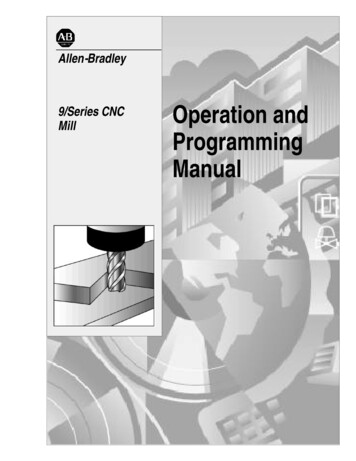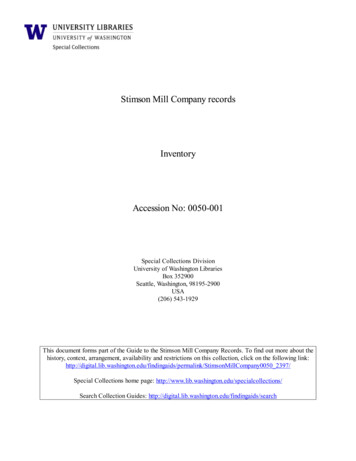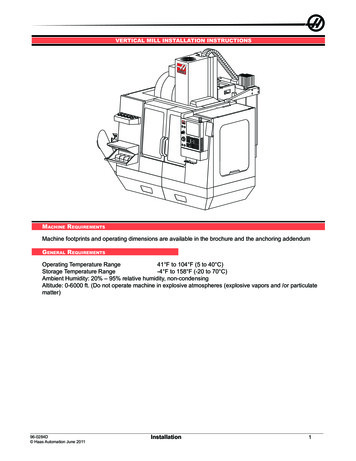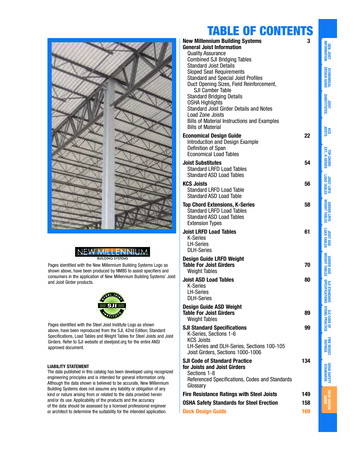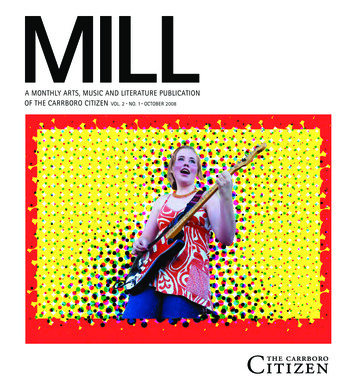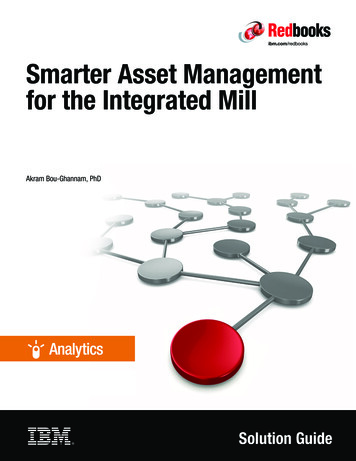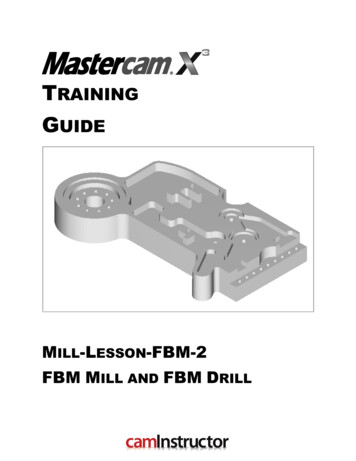
Transcription
The Storyof The MillFrom a Mission to aMovementWritten by Debbie RobinsonEdited by Elizabeth Williamson 3
Table of ContentsNew Beginnings: The Man 7New Beginnings: The Mission. 11Road Trip to Nashville. 15Coming Home. 19Where Broken Hearts are Mended. 23Possess The Land. 25A Time of Decision. 28Faith Without Sight. 33The Right Man. 37The Time Is Now. 41Fulfilling a Vision. 45At a Crossroads. 51Greater. 55Pastors of The Mill. 57Acknowledgements. 58The story and these pages was recordedto celebrate 30 years ofGod’s faithfulness to The Mill.Printed February, 2018. 4 5
I can do all things through him who strengthens me.– Philippians 4:13New Beginnings: The ManAh retirement. That word alone evokes thoughts ofrelaxation, being able to come and go as you please andpursuing hobbies and pleasures not possible on a workdayschedule. After a lifetime of labor, retirement sounds likea dream to most hard-working people. The future heldthat dream for one man and his wife and even included alakefront home.But God had other plans. He would immerse that man ina project demanding energy, time, finances and detailedplanning – all at a time when his health was beginning todecline. His wife admits, “there were times I thought he wascrazy!” But she quickly adds that he considered this venture“one of his greatest joys and a wonderful way to close outhis ministry.” The story of this man and the founding of achurch testify to the reality and beauty of God’s calling andprovision. Floyd David Loudermilk was born on December 4, 1920in Anderson, South Carolina. He was the youngest of 10children, and his father died when Floyd was ten years old.He left high school before graduating and, in an effort tohelp his mother, went to work at a Dixie Home store (nowknown as Winn-Dixie) in Greenville. He became its managerat just 17 years old.Floyd felt God calling him to the ministry; he chose instead“to run from God,” said his wife. His running lead him to jointhe United States Army to serve in World War II. One nightduring the war, a life or death situation found Floyd praying,“God, if You get me out of this, I will serve You.”After the war, Floyd met Sara Getsinger, who was then 18years old. Within six months they became engaged and 6 7
were married. They soon moved to Long Creek, SouthCarolina.Floyd entered Long Creek Academy, which was affiliatedwith the Baptist Home Mission Board and was originallyestablished as a high school for rural community children.He and Sara worked at the academy’s farm, the businessconcern which sustained the school, while Floyd finishedhis high school diploma.While there, Floyd acted as pastor for two area churches,preaching at each church on alternate Sundays. It wasalso during their stay at Long Creek, 10 months after theirmarriage, that their daughter Brenda was born.After finishing his high school education, Floyd enrolledat North Greenville University, which was then a two-yearcollege. He and Sara moved into a Quonset hut earmarkedfor married student housing.He graduated and eventually enrolled at Fruitland BibleCollege in Hendersonville, North Carolina while alsobecoming the full-time pastor of New Bethel Baptist Churchoutside of Anderson.After graduating from Bible college, Floyd held a numberof pastorates: New Pleasant Baptist Church near Cowpens,South Carolina; a Baptist church in Warrenville, SouthCarolina; and New Hope Baptist Church in Earl, NorthCarolina. He also completed a brief assignment with theHome Mission Board in Grant’s Pass, Oregon.In 1960, Floyd accepted the position of pastor at OakGrove Baptist Church in Spartanburg. He served therewith his family, now including sons David, Bobby andWade, until 1983.At age 62, Floyd retired, and he and Sara bought a lot andmobile home on the shores of Lake Hartwell. While there,he served as interim pastor for several churches, but theremoteness of the lake area and the need to be closer to 8 their children brought them back to Spartanburg in 1987.After relocating, Floyd became the interim pastor at FiveForks Church in Simpsonville. It was during that time thatDr. Alvin O’Shields with the Spartanburg Baptist Associationand a local Baptist pastor named Dr. Dan Cloer approachedFloyd with a proposal to start a mission on the west side ofSpartanburg. There were only two Baptist churches servingthis rapidly growing area of town, where subdivisions suchas Londonderry and Woodridge were beginning to bringfamilies by the dozens. There was a need to reach peoplefor Christ.Floyd, then 68, accepted the assignment. In February of1988, Floyd and Sara held a meeting in their living room,and Anderson Mill Road Baptist Church was born. Why might God have chosen Floyd Loudermilk, whywould he accept what God was offering him, especially inthe midst of his retirement? There may have been threereasons: his willingness, his faith and his heart.The history of his ministry speaks to his willingness. Fromthe war to Simpsonville, Floyd did what God asked. Thoughit would mean relocating his family as jobs changed andspending time on the road, this man was willing. In fact, oneof his core beliefs, according to his family, was that Godwould provide for those who are in the center of His will. IfFloyd had not been willing to take on such a huge project,someone else would have been given that opportunity; hewould have missed the adventure, as well as the joy.The belief in God’s faithfulness stood at the cornerstoneof Floyd’s faith. In fact, his daughter Brenda said that herfather constantly spoke of the ways in which God providedat various times in his life. Brenda recalls one such example:In the days when money was scarce, a church member left aburlap sack containing two live chickens on the doorstep ofthe Loudermilks’ home. They killed and cooked the chickens 9
and burned the sack. The church member came to Floydthe next day and asked him if he had liked the gift. “Thankyou. The chickens were delicious,” he said. The man asked,“What about the money?” “What money?” asked Floyd.“The 50 bill I put in the sack with the chickens,” replied theman. Floyd hurried back to the ash heap and found a smallpiece of the burlap sack amongst the ashes. He unfolded itto find the 50 bill inside, unburned and intact. It was clearevidence of God’s provision.As he walked through the mission project and all thatit entailed, Floyd would need to personally know God’sfaithfulness to provide what he needed. All he had to dowas look at his life.Finally, his heart was important. When asked to describeher husband, Sara said very simply, “He loved people.” Shesaid his heart would break when there were disagreementsamong the church leadership.His heart went out to young people and he often attendedthe church youth camps. His daughter said, “What attractedkids to him was that he trusted them to take responsibilityand ownership of what they did.”Floyd’s attention to his mother was further evidence of aheart that loved. He took care of her throughout her life,making sure that she wanted for nothing. His love for peopleallowed him to see the need for Christ in those around him.Floyd’s life speaks volumes of his commitment to theministry, but it was his character and devotion to God thatis most noteworthy. When he passed away on December 4,1996, Reverend Floyd Loudermilk’s obituary was noticeablyshort. He did not want too much made of his life, so he didnot want the usual visitation and service after his passing.He sought no honor of his own, only that which was duehis God. What mattered was what God was called him todo. God knew that about him and chose the right man forthe job. 10 So the church throughout all Judea and Galilee and Samariahad peace and was being built up. And walking in the fear ofthe Lord and in the comfort of the Holy Spirit, it multiplied.- Acts 9:31New Beginnings: The MissionBeginning in the early 1980s, Forest Acres Baptist Churchfaithfully met every Sunday in the basement of a SeventhDay Adventist Church. The congregation, led by Dr. Dan Cloer,originally consisted of 70 members. Over time, however,efforts to grow the congregation were not successful.By the late 1980s, the church dwindled down to about 15mostly elderly members. A January 1988 vote formallydisbanded the church and appointed trustees over moniesaccumulated from faithful giving. The following month,these hardy souls joined the Loudermilk family in Pastorand Mrs. Loudermilk’s living room for a potluck dinner anddiscussion about forming a mission.A Southern Baptist Association report designated AndersonMill Road as one of four Spartanburg County areas in needof a local church. Armed with that knowledge, the group’sfirst order of business was to find a location for the missionthat would be central to Anderson Mill Road.By the end of February 1988, Pastor Loudermilk secured anempty storefront in the West Oak Square shopping center atthe corner of Reidville and Anderson Mill Roads. For a 500per month rental fee, the “Spartanburg Mission” now had ameeting place.Between 30 and 40 people attended the first Sunday serviceat the end of February, with the number swelling to over 100within the next three months. The 25-by-50-foot space,originally empty, was now filled with chairs of different sizesand colors; some had been donated by West Side BaptistChurch, and others had been brought by the individualmembers. There was barely room for a pulpit and a coupleof chairs at the front. 11
The nursery, set up in a converted mop closet next to theworship space, presented its own difficulties. Not only couldthe congregation hear crying babies during worship, but,as charter member Harold Brock said, “The smell of theammonia was pretty strong when the babies were gettingchanged.”Volunteers offered to do everything from the custodialto the secretarial. Sunday bulletins were written by handand shared. According to Pastor Loudermilk, one of themission’s greatest needs was “personnel who work free!”1In the end, everyone did just that. People willingly served ina wide range of capacities from overseeing church financesto leading musical worship to investing in children.With the congregation’s number increasing, it was obviousthat the small space could not hold much more. Themission rented two adjoining spaces and, with the owners’permission, removed the common walls to expand thesanctuary. They did this with the provision that those wallswould be rebuilt upon the end of the lease. As Harold Brocksaid, “We didn’t even know if they were load-bearing walls.We just knocked them down and hoped for the best!”The mission’s leadership looked to nearby businesses thatwere closed on Sundays to ask if their spaces could be usedfor Sunday School classes. It wasn’t long before membersbegan to meet in a restaurant (The Galley), a barber shop,a gym and a satellite office of the Spartanburg HeraldJournal for small group Bible studies. The senior adult classmet in the sanctuary, and another class met at the Cloer’shome across Reidville Road. They used movable panelsto separate spaces in the sanctuary to accommodateadditional classes. After the expansion, the congregationclimbed to 150.Pastor Loudermilk’s last interim church, Five Forks inSimpsonville, was building a new sanctuary and offered itsold pews to the mission. Harold and Gerry Brock personallypurchased them, as well as the pulpit, fiberglass baptismalpool and three large chairs for the mission. The missionused the pews that fit into the space and placed the restin storage. A sign reading “Family of God” hung abovethe expanded sanctuary, which now housed two services,Sunday School classes and a well-attended Sunday nightservice.With a growing congregation, the members could envisionan actual church building in their near future. Anticipatingthis, a Service of Constitution took place to move themission’s status from “mission” to “church.” West SideBaptist Church, which had so graciously allowed themission to use its campus for baptisms and fellowshipevents, served as the sponsoring church. The congregationchose a name based on its location.Within 10 months of the mission’s first service, the numberof members had grown to 250. It was time to build a facilityfor Anderson Mill Road Baptist Church. Considering the amount of work, time and money it tookto begin and sustain a fledgling church, what kept themgoing? Two motivating factors continue to be evident inthe recounting of this history: God’s provision and thecongregation’s love for each other.“God’s hand was on this” was a phrase often heard inconversation with the charter members. God not onlysupplied the necessary space and resources, but energizedthe people with the excitement of seeing growing numbersregularly attending each Sunday.Bobby Loudermilk, the first outreach leader, recalls theextraordinary efforts of the visitation team and the way thenews spread about the mission by word-of-mouth. Thisalso had a financial benefit.1Video, early Spartanburg Mission Service, courtesy of Wade Loudermilk 12 13
Sara Loudermilk recalled finding money in the church’smailbox, often from people who did not attend, but whohad heard of the mission’s existence. These donationssupplemented the congregation’s consistent giving andthe seed money donated by Forest Acres Baptist Church.By the end of July 1988, just six months its inception, thechurch had 90,000 in its bank account, with 10 percentallocated for missions. This was truly amazing, consideringthe relatively small number of people in the congregation.It was simply further evidence of God’s blessing andprovision.The congregation’s love for each other was evident throughmembers’ encouragement of one another and the work theydid to benefit the mission. It was apparent in the way theyextended themselves to others.Charter members Fred and Dianne Wofford said that theirreason for attending and staying at the mission was thepeace and presence of the Holy Spirit they felt there. Therewas a feeling of family and a unity in purpose.Members affirmed their love at the closing of each serviceas they held hands across the aisle and sang “I’m so gladI’m a part of the family of God.” When church ended, it wascommon for people to stay one or two extra hours, just tofellowship with each other.God’s provision and the congregation’s love for each otherwould be important as they faced the challenge of buildinga church facility. They were off to a truly good start. As for that in the good soil, they are those who, hearing theword hold it fast in an honest and good heart, and bear fruitwith patience.- Luke 8:15Road Trip to NashvilleBuilding a facility for the church could have been a scaryand overwhelming endeavor. There were many challenges.How would they build for their current needs while alsoanticipating future growth? The new facility would needto accommodate people in various stages of life – babiesthrough senior adults.And, of course, the congregation would need to pay for thefacility, which could be staggering for a relatively smallcongregation. Their faith fueled their determination toaccomplish this project. God had provided for them fromday one.The first step in the process was research, and TheSouthern Baptist Convention offices in Nashville would bea good place to start. Pastor Loudermilk and a group fromthe church traveled in the Brocks’ RV.When they arrived in Nashville, they met withrepresentatives of the convention’s ArchitecturalDepartment. The group presented their history and wherethey felt God was leading in terms of building. The panel hada rather disheartening response. In their opinion, the projectwould cost about 100 per square foot, requiring roughly 5million to complete. The panel further recommended thatthe group wait five years to build and urged them to“go back and grow.”The group headed home discouraged. At a rest stop on theway back, Pastor Loudermilk, convinced of both God’s willin the matter and His provision, told the group, “Don’t bediscouraged. We will build this church.” 14 15
With 90,000 in the bank, the next step was to find a pieceof land for the church. A seven-acre property on the cornerof Anderson Mill Road and Sundyal Drive seemed the bestchoice. Unfortunately, it was not for sale. Fortunately, thecurrent owner of the land was an acquaintance of a chartermember of the mission.Two members of the congregation knocked on the landowner’s door and asked if she would be willing to sell the land.She refused. However, a week later, she accepted their offer.The land was theirs. The mission hired attorney Lloyd Howardwas hired to handle the title search and other legal issues.After purchasing the land, there were no funds left to build.Next on the agenda was to find some kind of financing.This was a difficult task. The church’s giving history wasnot long enough to guarantee income with which to repay aloan, and the once robust bank account had been depletedby the land purchase. Also, as Harold Brock said, “To getmoney to build a church is the hardest thing in the world,because no one person is responsible.”Jim Cantrell, a banker with First Citizen’s Bank and Trust,approached his bank for a loan. He submitted a proposal,and, as he recalls, the loan officers laughed at him.When he returned to the church members and told themwhat had happened, approximately 50 people decidedto pledge 5,000 each, should the church default on theloan. Oddly enough, when given this information, the bankdecided to take a chance, and loaned the church 600,000to build.The Home Mission Board, acting as a sort of backup, alsopledged to provide the money for the loan, in the event ofdefault. The members’ financial commitment might haveseemed risky, but as Harold Brock said, “Things had beengoing so well, and they knew that God would provide.”Fortunately that offering was in force for a relatively shorttime, and a later refinancing relieved the members of thepotential burden. 16 In order to cut costs, the church hired a contractor insteadof an architect to draw up the plans for the envisioned20,000 square foot building. It would house a sanctuary,fellowship hall and educational space.In the end, the total cost of the project, including the land,was approximately 700,000. The cost was about 24 persquare foot, a significantly lower figure than the SouthernBaptist Convention group in Nashville had estimated.The groundbreaking took place on December 4, 1988,only 10 months after the famous Loudermilk living roommeeting. Various subcontractors worked on the project atamazingly reasonable rates.The project was not without its challenges, however, andcost-cutting was the rule of the day. Professionals installedthe septic system, but it was the men of the church who dugand placed the lines.Resourcefulness was a mandatory. An example was thelack of dirt for the grading. Rather than paying for dirt, theyadded a basement to the plans. The basement made up
college He and Sara moved into a Quonset hut earmarked for married student housing He graduated and eventually enrolled at Fruitland Bible College in Hendersonville, North Carolina while also becoming the full-time pastor of New Bethel Baptist Church outside of Anderson After graduating
